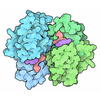[English] 日本語
 Yorodumi
Yorodumi- SASDCT5: SAXS on intact Doryteuthis squid lens 40% layer (S-crystallin, Q2... -
+ Open data
Open data
- Basic information
Basic information
| Entry | Database: SASBDB / ID: SASDCT5 |
|---|---|
 Sample Sample | SAXS on intact Doryteuthis squid lens 40% layer
|
| Function / homology |  Function and homology information Function and homology information |
| Biological species |  Doryteuthis pealeii (longfin inshore squid) Doryteuthis pealeii (longfin inshore squid) |
 Citation Citation |  Journal: Science / Year: 2017 Journal: Science / Year: 2017Title: Eye patches: Protein assembly of index-gradient squid lenses. Authors: J Cai / J P Townsend / T C Dodson / P A Heiney / A M Sweeney /  Abstract: A parabolic relationship between lens radius and refractive index allows spherical lenses to avoid spherical aberration. We show that in squid, patchy colloidal physics resulted from an evolutionary ...A parabolic relationship between lens radius and refractive index allows spherical lenses to avoid spherical aberration. We show that in squid, patchy colloidal physics resulted from an evolutionary radiation of globular S-crystallin proteins. Small-angle x-ray scattering experiments on lens tissue show colloidal gels of S-crystallins at all radial positions. Sparse lens materials form via low-valence linkages between disordered loops protruding from the protein surface. The loops are polydisperse and bind via a set of hydrogen bonds between disordered side chains. Peripheral lens regions with low particle valence form stable, volume-spanning gels at low density, whereas central regions with higher average valence gel at higher densities. The proteins demonstrate an evolved set of linkers for self-assembly of nanoparticles into volumetric materials. |
 Contact author Contact author |
|
- Structure visualization
Structure visualization
| Structure viewer | Molecule:  Molmil Molmil Jmol/JSmol Jmol/JSmol |
|---|
- Downloads & links
Downloads & links
-Data source
| SASBDB page |  SASDCT5 SASDCT5 |
|---|
-Related structure data
| Related structure data | C: citing same article ( |
|---|---|
| Similar structure data |
- External links
External links
| Related items in Molecule of the Month |
|---|
-Models
| Model #1364 |  Type: dummy / Software: (1.1.2) / Radius of dummy atoms: 4.20 A / Symmetry: None / Comment: An invert method has been applied. / Chi-square value: 2.765569  Search similar-shape structures of this assembly by Omokage search (details) Search similar-shape structures of this assembly by Omokage search (details) |
|---|
- Sample
Sample
 Sample Sample | Name: SAXS on intact Doryteuthis squid lens 40% layer |
|---|---|
| Buffer | Name: Tissue fluid / pH: 7 |
| Entity #672 | Name: S-crystallin, Q25367 / Type: protein / Description: S-crystallin, Q25367_DOROP / Formula weight: 27.289 / Num. of mol.: 2 / Source: Doryteuthis pealeii / References: UniProt: Q25367_DOR Sequence: MPTYTLYYFN GRGRAEVLRM MFAAANVKYM DKRFEFNEWD KYRKDMPSMC VPVLEMDGGN KMPETMAIPR YLAREFGFYG KSNMDMMRCD YIADCFYEIM HDYMRYFHEK NGRFRSSMEG SGNGMNSPTG ASGDMNSNSN FDTYLQWRFM NTCNRVLPFL ERTLEMQNGG ...Sequence: MPTYTLYYFN GRGRAEVLRM MFAAANVKYM DKRFEFNEWD KYRKDMPSMC VPVLEMDGGN KMPETMAIPR YLAREFGFYG KSNMDMMRCD YIADCFYEIM HDYMRYFHEK NGRFRSSMEG SGNGMNSPTG ASGDMNSNSN FDTYLQWRFM NTCNRVLPFL ERTLEMQNGG KAFFMGDQMM WCDMMCHCAL EGPFMENQSM LSKHPKLMAL RTRIASHPKI SGYLKSRSNT NW |
-Experimental information
| Beam | Instrument name: National Synchrotron Light Source (NSLS) X9A City: Brookhaven, NY / 国: USA  / Type of source: X-ray synchrotron / Wavelength: 0.1 Å / Type of source: X-ray synchrotron / Wavelength: 0.1 Å | ||||||
|---|---|---|---|---|---|---|---|
| Detector | Name: Pilatus 300K / Type: 20Hz | ||||||
| Scan |
| ||||||
| Result | Experimental MW: 50 kDa / I0 from PR: 180 / Rg from PR: 2.4 nm / Type of curve: single_conc Comments: The space-filling model ultimately represents the spatial density fluctuation of the material, not the presence of material. Since we measured a nearly water-free density of material at ...Comments: The space-filling model ultimately represents the spatial density fluctuation of the material, not the presence of material. Since we measured a nearly water-free density of material at the core of the lens, we show the void density of the model prediction here. |
 Movie
Movie Controller
Controller












